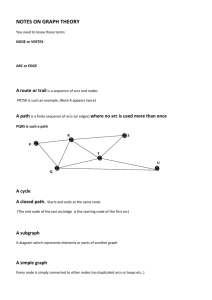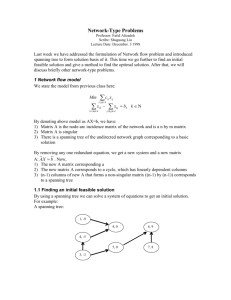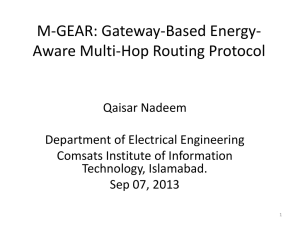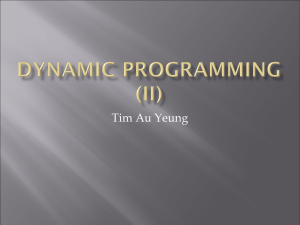Document
advertisement
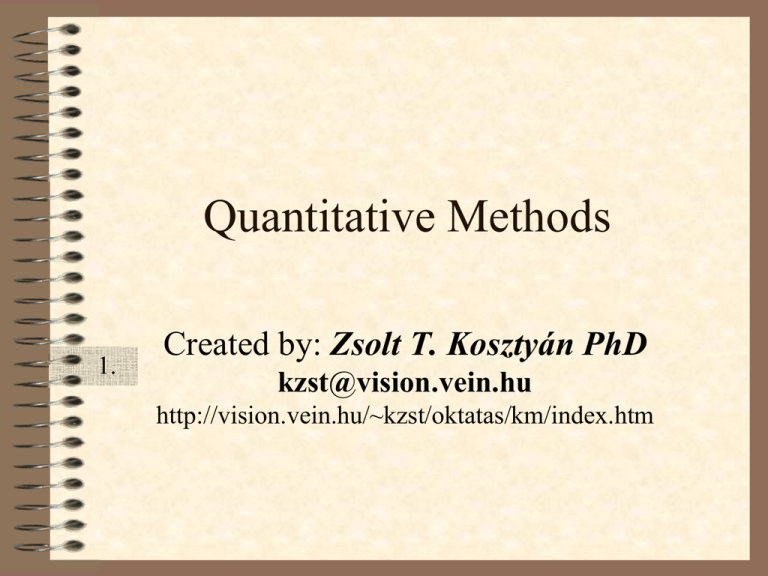
Quantitative Methods
1.
Created by: Zsolt T. Kosztyán PhD
kzst@vision.vein.hu
http://vision.vein.hu/~kzst/oktatas/km/index.htm
The aim of this course
• Scope: Introduce quantitative methods,
theories and its applications of
management science.
Syllabus
•
•
•
•
•
•
•
•
•
•
1st lecture: Introduction to Theories and its Applications of Graphs (Shortest Path
Problems; Maximal Flow Problem; Minimal Spanning Trees; and these
applications in Logistics)
2nd lecture: LP problems and applications in productions and transfer problems
3rd lecture: Flow Shop and Job Shop modells. EOQ.
4th lecture: Scheduling problems. Theories and its Applications in Project
Management and Small-scale Series Production Management
5th lecture: Cost and Resource Allocation.
6th-9th lecture: Advanced Statistical Methods (Regression Analysis, Principal
Component Analysis, Factor Analysis, Analysis of Variance, Cluster Analysis,
Contingence Analysis, Path Analysis
10th lecture: Forecasting
11th-12th lecture: Statistical Process Control. Expression of Measuring
Uncertainties.
13th lecture: Test. Simulation Techniques (Monte Carlo Simulations).
14th lecture: Make-up test. Using different kind of Softwere Developement Tools
for Solving Quantitative Problems.
Characterics of Methods
• Heuristic Methods
– Feasible solution can be reach easily
– Cannot guarantee the optimal solution
• Algorithmic methods
– Finding optimal solution can be guaranteed.
– Slower methods than heuristic ones
• Evolution methods
– Mix of the heuristic and the algorithmic methods
– The initial solution can be a feasible solution
determined by heuristic method. This solution will be
improved.
– The optimal solution cannot be guaranteed in finite
step (but usually garanteed in infinite step)
Short View of History in Graph
Theory
• 1735 Euler solves the problem of bridges in
Königsberg.
• 1847 Kirchoff has applied theory of graphs for
characterising electronic circuits.
• 1852 F. Guthrie: Suggestion of four colour
problem.
• 1857 Cayley has applied graph theory in
chemistry.
• 2nd World War: Solving Logistic Problems with
Using Graph Theories.
• 1960s CPM, PERT.
Graph Theory – Terms and
Definitions I
– Graph: G=(N,A) contains of a set N of nodes and a set A of arcs which
elements are ordered/unordered pairs of distinct nodes.
– Directed Graph: arcs are ordered pairs of distinct nodes.
– Undirected Graph: arcs are unordered pairs of distinct nodes.
(Ni, Nj)= (Nj, Ni)
Directed Graph
2
1
Undirected Graph
4
2
5
3
1
4
5
3
– Weighted Graph: A weighted graph is a graph in which each branch is
given a numerical weight.
Terms and definitions II
•
•
Subgraph: A Gp=(Np,Ap) graph is a
subgraph of G=(N,A) if NpN, ApA
I.e: G:=(N,A); N:={1;2;3;4;5},
A:={(1,2);(1,3);(2,3);(2,4);(3,5);(4,5)},
Gp:=(Np,Ap); Np:={1;2;3;5},
Ap:={(1,2);(2,3);(3,5)}
2
1
4
5
3
Terms and Definitions III
– Walk: A walk is a sequence of arcs and nodes such that the arcs and nodes are
adjacent.
– Directed Walk: A directed walk is an ”oriented” version of a walk in the sense
that for any two consecutive nodes are on the walk.
– (Directed) Path: A (directed) path is a (directed) walk without any repetition.
– Closed (Directed) Walk: A closed (directed) walk is a subset of the arc set of G
that forms a walk such that the first node of the walk corresponds to the last.
– (Directed) Cycle: (directed) cycle is a closed (directed) walk without any
repetition.
Directed path
2
Undirected path
2
4
1
5
3
(b)
4
1
5
3
(a)
Terms and definitions IV
-
-
Loop: arc which tail node is the same as
its head node.
Multiarcs: two or more arcs with the
same tail and head nodes.
i.e.: G:=(N,A); N:={1;2}, A:={(1,2);
(1,2); (2,2)}
Simple graph: no contains multiarcs or
loops.
1
2
Terms and definitions V
• Isolated nodes: Nodes without arcs.
Let G=(N,A) an undirected graph.
• Number of nodes: N Ni
N N ,i 1, 2,..,n
• Number of arcs: A Ai
A A,i 1, 2,..,m
• Indegree: ( N i ) A j
i
i
A j ( N k , N i ) A
• Outdegree: ( N i )
A
j
A j ( N i , N k ) A
• Degree: ( Ni ) ( Ni ) ( Ni )
Terms and defintions VI
– Connectivity: We will say that two nodes i and j are
connected if the graph G contains at least one path from
node i to node j. A graph is a connected if every pair of its
nodes is connected; otherwise the graph is disconnected.
– Strong Connectivity: A connected graph is strongly
connected if it contains at least one directed path from every
node to every other node.
– Tree: A tree is a connected graph that contains no cycle.
– Forest: A graph that contains no cycle is a forest.
Alternatively, a forest is a collection of trees
11
Terms and definitions VII
- Neighbours: A pair of nodes is a neighbour if
they have an arc connecting them.
- Complete graph: Complete graphs have the
feature that each pair of nodes has an arc
connecting them.
1
2
3
4
Terms and definitions VIII
- A subgraph H is a spanning subgraph, or
factor, of a graph G if it has the same arc
set as G. We say H spans G.
- A spanning tree is a spanning subgraph
that is a tree.
1
2
3
4
Representing graphs
(1,2)
(1,5)
(2,3)
(2,4)
(2,5)
(3,4)
(4,5)
1
1
1
0
0
0
0
0
2
1
0
1
1
1
0
0
3
0
0
1
0
0
1
0
4
0
0
0
1
0
1
1
5
0
1
0
0
1
0
1
Incidence matrix
Adjacency list
Adjacency matrix
Finding Minimum Spanning
Trees
• Minimum Spanning Tree: A subgraph of
a weighted graph is a minimal spanning
tree, if a spanning tree with minimal cost.
Kruskal’s algorithm
O(m+n·log(n))
2
O(n ),
Prim’s algorithm
O(m+n·log(n))
2
O(n ),
Shortest Path Problem –
Dijkstra’s algorithm O(n2)
Isomorphic graphs
• A G1=(N1,A1) graph is an
isomorphic graph of
G2=(N2,A2) graph, if
:N1N2, and
f:A1A2 bijective
functions.
• In the case when the
bijection is a mapping of a
graph onto itself, it is
called an automorphism.
Topological ordering
• A G=(N,A) directed acyclic graph is topological
ordered if Ni,NjN and (Ni,Nj)A then Nj
followed by Ni in a list.
The graph shown to the left has many valid topological sorts,
including: 7, 5, 3, 11, 8, 2, 9, 10 (visual left-to-right, top-tobottom)
•3, 5, 7, 8, 11, 2, 9, 10 (smallest-numbered available arc first)
•3, 7, 8, 5, 11, 10, 2, 9
•5, 7, 3, 8, 11, 10, 9, 2 (least number of node first)
•7, 5, 11, 3, 10, 8, 9, 2 (largest-numbered available arc first)
•7, 5, 11, 2, 3, 8, 9, 10
Topological ordering – Phase I
1. We select source nodes into first stage.
2. Outgoing arcs of these nodes will be erased.
3. Select source nodes in the modified graph into
next stage.
4. GO TO STEP 2 until there are any unselected
nodes.
5. Connect nodes regarding the initial graph.
Topological ordering – Phase I
1
2
10
3
9
4
8
4
3
5
5
2
6
1
10
7
6
7
9
8
I.
II.
III.
IV.
V.
VI.
Topological ordering – Phase II
(SPP) O(n+m)
0
3
2
2
7
6
8
5
u
t
-1
5
6
8
s
8
8
r
1
v
4
2
x
-2
3
4
8
6
Maximal flows – terms &
definitions
• The G=(N,A) a weighted directed graph is a network,
if !s,tN, node s is the source (no contains
incoming arcs); node t is the sink (no contains
outgoing arcs).
• The capacity of an arc is a mapping c:AR+. It
represents the maximum amount of flow that can
pass through an arc.
• A flow is a mapping f:N2R subject to the
following two constraints:
1. f(n1,n2)=-f(n2,n1) (n1,n2)A, n1,n2N
2. f(n1,n2)c(n1,n2), n1,n2N
• The initial flow is 0. f n1, n2 0, n1, n2 N \ s, t
n2N
Maximal flows – terms & definitions
• The arc (ni,nj) is saturated if f(ni,nj)=c(ni,nj). The
value of flow f defined by |f|, where
f : f s, n
nN
• Let G=(N,A) a network. s-t cut C=(S,T) is a
partition of N (ST=N, ST=) such that s∈S
and t∈T. The cut-set of C is the set {(u,v)∈A |
u∈S, v∈T}. Note that if the nodes in the cut-set of
C are removed, | f | = 0.
cS , T :
cs, t
sS ,tT
Maximal flows – terms & definitions
• Let G=(N,A) a flow network. Node s a
source node, and t a sink node. If
capacities c:AR+ , and flows f:N2R
of the arcs are given, than the residual
capacity can be definied as follows:
r:AR
where
if
n1,n2N
r(ni,nj):=c(ni,nj)-f(ni,nj). The Residual
Graph of flow f is graph Gf=(N,Af)
with residual capacity function r, where
Af ={(ni,nj)| ni,njN, r(n1,n2)>0}.
Maximal flows – terms & definitions
• An augmenting path is a path
(u1,u2,…,uk) in the residual network,
where u1=s, uk =t, and r(ui, ui+1)>0. A
network is at maximum flow if and
only if there is no augmenting path in
the residual network. If there is
available
capacity
along
the
augmenting path the minimal
residual capacity of the augmenting
path is defined as critical capacity.
Max-flow min-cut theorem
• In optimization theory, the max-flow mincut theorem states that in a flow network,
the maximum amount of flow passing from
the source to the sink is equal to the
minimum capacity which when removed in
a specific way from the network causes the
situation that no flow can pass from the
source to the sink.
Ford-Fulkerson’s algorithm
• The idea behind the algorithm is very
simple: As long as there is a path from the
source (start node) to the sink (end node),
with available capacity on all arcs in the
path, we send flow along one of these
paths. Then we find another path, and so
on. A path with available capacity is called
an augmenting path.
Ford-Fulkerson’s algorithm
111;;01
;001
;
1
1
1
;
1
1
2
1
t
1;1
1 11
tt
1 11
2
vv
v
21w
2
22 2
2
tt
w
w
1
u
uu
2;2
v 11
1
133
2;2
2;1
2;0
11 1
ss
s
00
22; ;
3;2
vvv
2;2
0
2;
s
1
;
0
sss ;1
1 333;;
;001
222;;010
u
11;;10
;11
11;0
uu
w
w
w
t
Ford-Fulkerson’s algorithm
u
100
2
10
0
1
2
s
2 100
0
0
1
v
2
t
Edmondson – Karp’s heuristic
algorithm O(m2n)
• The algorithm is identical to the Ford–
Fulkerson algorithm, except that the search
order when finding the augmenting path is
defined. The path found must be the
shortest path which has available capacity.
u
100
2
100
1
2
s
2 100
100
v
2
t
Multi-source multi-sink
maximum flow problem
• Given a network G=(N,A) with a set of
sources S={s1, ..., sn} and a set of sinks
T={t1, ..., tm} instead of only one source
and one sink, we are to find the maximum
flow across G. We can transform the multisource multi-sink problem into a maximum
flow problem by adding a consolidated
source connecting to each node in S and a
consolidated sink connected by each node
in T with infinite capacity on each edge.
Multi-source multi-sink
maximum flow problem
s1
8
s3
s5
7
11
2
k3
k4
15
6
20
13
18
t1
t2
8
s4
8
14
k2
3
8
8 8 8
S
12
5
k1
8
8
s2
10
t3
T
Thank you for your kind
attention!
References
• Ravindra K. Ahuja, Thomas L. Magnant,
James B. Orlin: Network Flows. PRENTICE
HALL, Upper Saddle River, New Jersey
1.

